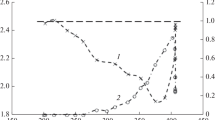Abstract
Hydrotalcitelike Co-Al and Ni-Al catalysts of different compositions (with the atomic ratio M 2+/Al3+ = 0.5–3.0) were studied in the reaction of selective reduction of NO by propane, propylene, and n-decane in the presence of O2. The higher activity of the catalysts with M 2+/Al3+ = 0.5 is connected with high dispersity of Ni or Co cations stabilized by a significant amount of Al3+ ions. Propylene was shown to be the most efficient reducing agent for nitrogen oxide. The highest degree of conversion to the extent of 90–99% was attained at 400 and 420–440°C for Ni-Al and Co-Al samples, respectively. When propane and decane were used as reducing agents, the conversion of both catalysts was characterized by the volcano-shaped dependence on temperature due to the fact that the catalyst took part in the concurrent reaction of hydrocarbon (reducing agent) oxidation. Hydrotalcitelike materials are promising representatives of inexpensive bi- and multicomponent systems. The design strategy for new active catalysts for processes of purification of gas exhausts from NO x , that are stable in the presence of water and sulfur oxides, may be based on usage of hydrotalcites with modified ions introduced into them.
Similar content being viewed by others
References
Parvulescu, V.I., Grange, P., and Delmon, B., Catal. Today, 1998, vol. 46, no. 4, p. 233.
Sydbom, A. Blomberg, A., et al., Eur. Respir. J., 2001, vol. 17, no. 7, pp. 33–746.
Iwamoto, M. and Hamada, H., Catal. Today, 1991, vol. 10, no. 1, p. 57.
Shelef, M., Chem. Rev., 1995, vol. 95, no. 1, p. 209.
Amiridis, M.D., Zhang, T., and Farrauto, R.J., Appl. Catal., B, 1996, vol. 10, nos. 1–3, p. 283.
Burch, R., Breen, J.P., and Meunier, F.C., Appl. Catal., B, 2002, vol. 39, no. 4, p. 283.
Glebov, L.S., Zakirova, A.G., et al., Neftekhimiya, 2002, vol. 42, no. 3, p. 163 [Pet. Chem. (Engl. Transl.), vol. 42, no. 3, p. 143].
Epling, W.S., Yezerets, A., Park, P., and Cooper, B., Catal. Today, 2006, vol. 114, no. 1, p. 1.
Sadykov, V., Kuznetsova, T., et al., Catal. Today, 2006, vol. 114, no. 1, p. 13.
Allmann, R., Chimia, 1970, vol. 24, no. 3, p. 99.
Taylor, H., Mineral. Mag., 1973, vol. 39, no. 394, p. 377.
Drits. V., Sokolova T., Sokolova G., and Cherkashin V., Clays Clay Miner., 1987, vol. 35, no. 6, p. 401.
Cavani, F., Trifirò, F., and Vaccari, A., Catal. Today, 1991, vol. 11, no. 2, p. 173.
Trifirò, F., Vaccari, A., and Clause, O., Catal. Today, 1994, vol. 21, no. 1, p. 185.
Vaccari, A., Catal. Today, 1998, vol. 41, nos. 1–3, p. 53.
Vaccari, A., Appl. Clay Sci., 1999, vol. 14, no. 4, p. 161.
Centi, G., Arena, G.E., and Perathoner, S., J. Catal., 2003, vol. 216, nos. 1–2, p. 443.
Serwicka, E.M., Polish J. Chem., 2001, vol. 75, no. 3, p. 307.
Corma, A., Palomares, A.E., Rey, F., and Márquez, F., J. Catal., 1997, vol. 170, no. 1, p. 140.
Palomares, A.E., López-Nieto, J.M., et al., Appl. Catal., B., 1999, vol. 20, no. 4, p. 257.
Kannan, S. and Swamy, C.S., Appl. Catal., 1994, vol. 3, nos. 2–3, p. 109.
Kannan, S. and Swamy, C.S., Catal. Today, 1999, vol. 53, no. 4, p. 725.
Petkov, V. and Bakaltchev, N., J. Appl. Crystallogr., 1990, vol. 23, no. 2, p. 138.
Klyachko-Gurvich, A., Izv. Akad. Nauk SSSR, Otdel Khim. Nauk, 1961, no. 10, p. 1884.
Reichle, W.T., Yang, S.Y., and Everhardt, D.S., J. Catal., 1986, vol. 101, no. 2, p. 352.
Chen, H.-Y., Voskoboinikov, T., and Sachtler, W.M.H., Catal. Today, 1999, vol. 54, p. 483.
Shimizu, K., Maeshima, H., Satsuma, A., and Hattori, T., Appl. Catal. B, 1998, vol. 18, nos. 1–2, p. 163.
Author information
Authors and Affiliations
Corresponding author
Additional information
Original Russian Text © V.F. Tret’yakov, A.G. Zakirova, A.A. Spozhakina, M.V. Gabrovska, R. Edreva-Kardzhieva, L.A. Petrov, 2010, published in Kataliz v Promyshlennosti.
Rights and permissions
About this article
Cite this article
Tret’yakov, V.F., Zakirova, A.G., Spozhakina, A.A. et al. Selective reduction of nitrogen oxides by hydrocarbons on hydrotalcite Co and Ni catalysts. Catal. Ind. 2, 62–66 (2010). https://doi.org/10.1134/S2070050410010101
Received:
Published:
Issue Date:
DOI: https://doi.org/10.1134/S2070050410010101




